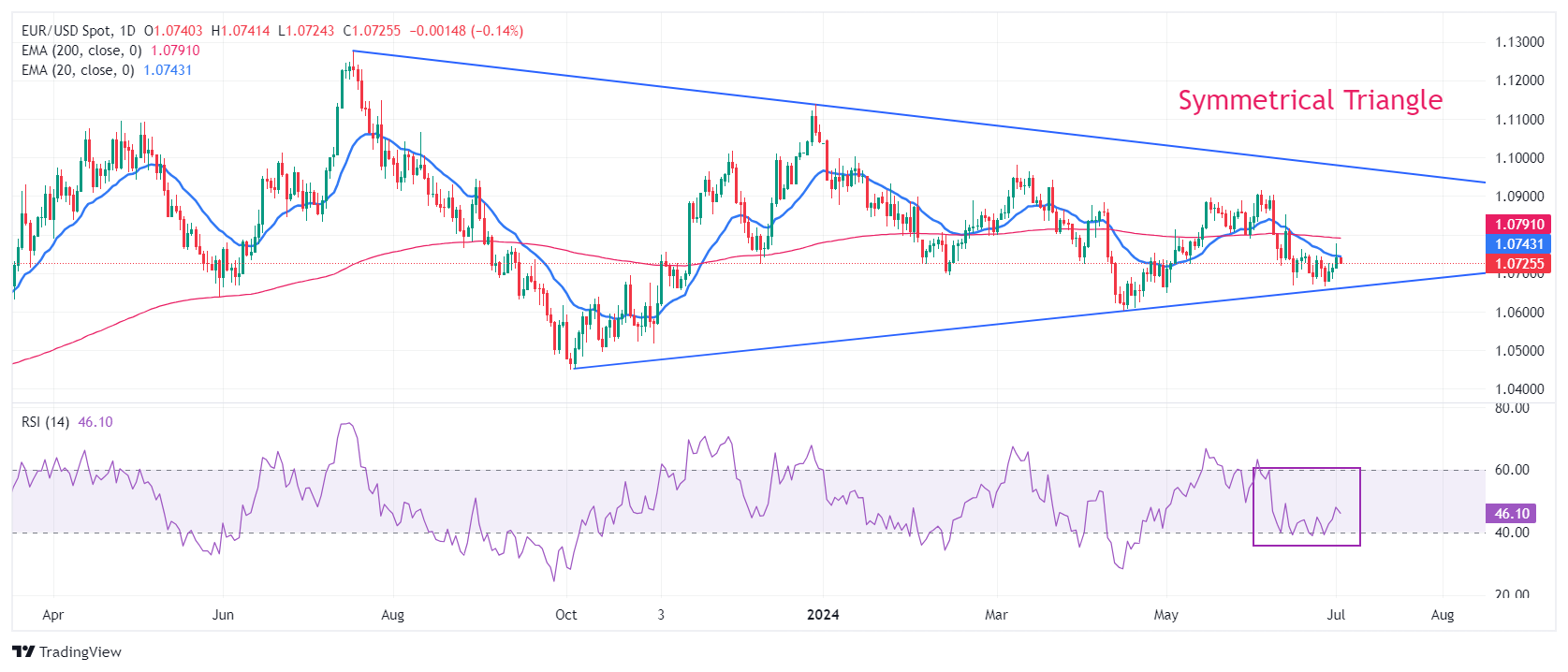- EUR/USD rebounds from 1.0700 after Fed Powell acknowledged that disinflation has resumed.
- Eurozone headline HICP softened expectedly in June, while core reading grew steadily.
- ECB Lagarde said inflation is heading in the right direction.
EUR/USD bounces back strongly from the intraday low near the round-level support of 1.0700 in Tuesday's American session. The major currency pair recovers after discussions between ECB President Christine Lagarde and Federal Reserve (Fed) Chair Jerome Powell at the ECB Forum on Central Banking in Sintra, Portugal. In conversation, ECB Lagarde acknowledged that inflation in the Eurozone economy is moving in the right direction and the central bank is very advanced in the disinflation path. She added, "We don't need to have services inflation at 2%."
Earlier, the Euro remained under pressure due to an expected decline in the preliminary Eurozone Harmonized Index of Consumer Prices (HICP) data for June. Annual HICP decelerated to 2.5%, as expected, year-on-year from May’s reading of 2.6%. In the same period, the core HICP, which excludes volatile components like food, energy, alcohol, and tobacco, grew steadily by 2.9%. Investors expected the underlying inflation to have declined to 2.8%. Core inflation measure rose at a steady pace due to sticky service inflation. Price pressures in the service sector rose in line with the pace of 4.1% as registered in May. Current inflation readings are unlikely to provide cues about where price pressures are heading.
On Monday, the preliminary German HICP report for June showed that price pressures softened more than expected, opening the door for the ECB to make back-to-back rate cuts. However, policymakers have refrained from providing a specific rate-cut path as they worry that an aggressive policy-easing campaign could revamp price pressures again.
On Monday, ECB Lagarde said, "It will take time for us to gather sufficient data to be certain that the risks of above-target inflation have passed." Lagarde added, "The strong labor market means that we can take time to gather new information," Reuters reported.
Meanwhile, uncertainty ahead of France’s second-round runoffs scheduled on July 7 will also keep the Euro on its toes. As per the exit polls for the first round of France's parliamentary elections, Marine Le Pen's far-right National Rally (RN) is in a comfortable position but with a smaller margin than projected.
Daily digest market movers: EUR/USD recovers as US Dollar gives away its entire intraday gains
- EUR/USD rebounds as the US Dollar (USD) retreats after Fed Powell said at the ECB Forum on Central Banking that progress in the disinflation process has resumed. However, they want to see more good inflation data before reducing interest rates. Powell added that the service inflation remains stickier and wage growth is above where they want to see. The comments were broadly similar to one delivered in the June's monetary policy meeting.
- On the economic front, the United States (US) ISM Manufacturing Purchasing Managers’ Index (PMI) report showed that factory activities unexpectedly declined in June. Data also indicated that inflationary pressures in the manufacturing sector, measured by the ISM Manufacturing Prices Paid Index, grew at a significantly slower pace than expected.
- The US Dollar Index (DXY), which tracks the Greenback’s value against six major currencies, edges lower to near 105.80 after failing to sustain above the crucial resistance of 106.00. Meanwhile, investors look for more cues about when the Federal Reserve (Fed) will start reducing interest rates this year. For that, investors will focus on the US Nonfarm Payrolls (NFP) report for June, which will be published on Friday.
- Currently, financial markets expect the Fed to start reducing interest rates from the September meeting. Two rate cuts this year, against only one cut projected by Fed policymakers in their latest dot plot, are expected.
- In the New York session, the US Bureau of Labor Statistics (BLS) reported stronger-than-expected JOLTS Job Openings data for May. New job vacancies came in at 8.14 million. Economists expected a slight decline to 7.9 million from April’s reading of 8.06 million.
Technical Analysis: EUR/USD holds key support of 1.0700
EUR/USD drops to near 1.0720 after failing to hold above the 20-day Exponential Moving Average (EMA), which trades around 1.0740. The major currency pair rebounded last week after discovering strong buying interest near the upward-sloping border of the Symmetrical Triangle formation on a daily timeframe near 1.0666, which is marked from 3 October 2023 low at 1.0448. The downward-sloping border of the above-mentioned chart pattern is plotted from 18 July 2023 high at 1.1276. The Symmetrical Triangle formation exhibits a sharp volatility contraction, which indicates low volume and narrow ticks.
The major currency pair remains below the 200-day Exponential Moving Average (EMA) near 1.0790, suggesting that the overall trend is bearish.
The 14-period Relative Strength Index (RSI) oscillates in the 40.00-60.00 range, suggesting indecisiveness among market participants.
Economic Indicator
Nonfarm Payrolls
The Nonfarm Payrolls release presents the number of new jobs created in the US during the previous month in all non-agricultural businesses; it is released by the US Bureau of Labor Statistics (BLS). The monthly changes in payrolls can be extremely volatile. The number is also subject to strong reviews, which can also trigger volatility in the Forex board. Generally speaking, a high reading is seen as bullish for the US Dollar (USD), while a low reading is seen as bearish, although previous months' reviews and the Unemployment Rate are as relevant as the headline figure. The market's reaction, therefore, depends on how the market assesses all the data contained in the BLS report as a whole.
Read more.Next release: Fri Jul 05, 2024 12:30
Frequency: Monthly
Consensus: 190K
Previous: 272K
Source: US Bureau of Labor Statistics
America’s monthly jobs report is considered the most important economic indicator for forex traders. Released on the first Friday following the reported month, the change in the number of positions is closely correlated with the overall performance of the economy and is monitored by policymakers. Full employment is one of the Federal Reserve’s mandates and it considers developments in the labor market when setting its policies, thus impacting currencies. Despite several leading indicators shaping estimates, Nonfarm Payrolls tend to surprise markets and trigger substantial volatility. Actual figures beating the consensus tend to be USD bullish.
Information on these pages contains forward-looking statements that involve risks and uncertainties. Markets and instruments profiled on this page are for informational purposes only and should not in any way come across as a recommendation to buy or sell in these assets. You should do your own thorough research before making any investment decisions. FXStreet does not in any way guarantee that this information is free from mistakes, errors, or material misstatements. It also does not guarantee that this information is of a timely nature. Investing in Open Markets involves a great deal of risk, including the loss of all or a portion of your investment, as well as emotional distress. All risks, losses and costs associated with investing, including total loss of principal, are your responsibility. The views and opinions expressed in this article are those of the authors and do not necessarily reflect the official policy or position of FXStreet nor its advertisers. The author will not be held responsible for information that is found at the end of links posted on this page.
If not otherwise explicitly mentioned in the body of the article, at the time of writing, the author has no position in any stock mentioned in this article and no business relationship with any company mentioned. The author has not received compensation for writing this article, other than from FXStreet.
FXStreet and the author do not provide personalized recommendations. The author makes no representations as to the accuracy, completeness, or suitability of this information. FXStreet and the author will not be liable for any errors, omissions or any losses, injuries or damages arising from this information and its display or use. Errors and omissions excepted.
The author and FXStreet are not registered investment advisors and nothing in this article is intended to be investment advice.
Recommended content
Editors’ Picks

EUR/USD flat lines above mid-1.0900s, investors seem non-committed amid rising trade tensions
The EUR/USD pair reverses an Asian session dip to the 1.0880 area and for now, seems to have stalled its retracement slide from the vicinity of mid-1.1100s, or the highest level since September touched last week. Spot prices currently trade around the 1.0960 region, nearly unchanged for the day amid mixed cues.

GBP/USD bounces off one-month low, defends 200-day SMA and retakes 1.2900
The GBP/USD pair attracts some dip-buyers near the 1.2830 region, or over a one-month low touched during the Asian session on Monday and for now, seems to have stalled its retracement slide from a six-month peak touched last week.

Gold price rebounds swiftly from multi-week low; lacks follow-through
Gold price reverses an Asian session slide to over a three-week low, though it lacks follow-through. Recession fears continue to weigh on investor sentiment and benefit the safe-haven commodity. Bets for more aggressive Fed rate cuts undermine USD and also lend support to the XAU/USD pair.

Bitcoin, Ethereum and Ripple head to yearly lows while ETH hits two-year bottom
Bitcoin price hovers around $78,600 on Monday after falling nearly 5% the previous week. Ethereum and Ripple also followed in BTC’s footsteps and declined 13% and 10%, respectively, in the previous week.

Strategic implications of “Liberation Day”
Liberation Day in the United States came with extremely protectionist and inward-looking tariff policy aimed at just about all U.S. trading partners. In this report, we outline some of the more strategic implications of Liberation Day and developments we will be paying close attention to going forward.

The Best brokers to trade EUR/USD
SPONSORED Discover the top brokers for trading EUR/USD in 2025. Our list features brokers with competitive spreads, fast execution, and powerful platforms. Whether you're a beginner or an expert, find the right partner to navigate the dynamic Forex market.




